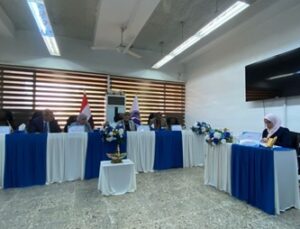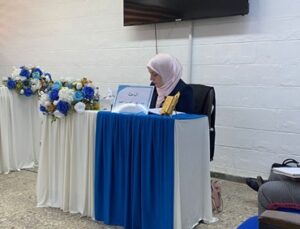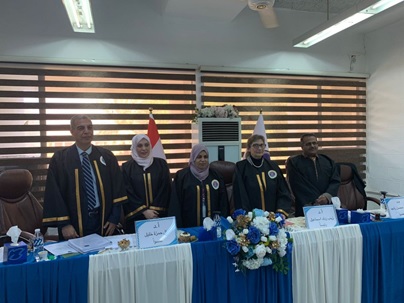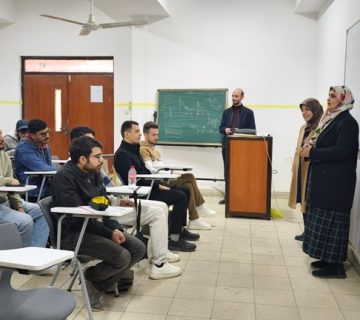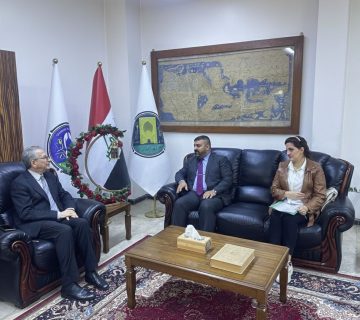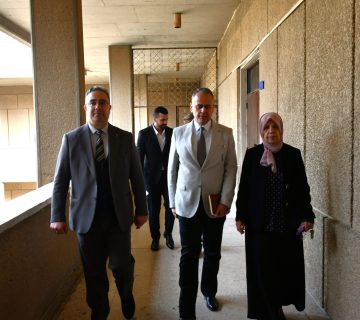Environmental Engineering Department at the College of Engineering, University of Baghdad, held MSc thesis examination titled:
“Synthesis of new nano-layered double hydroxide for sand coating used as a reactive sorbent material for amoxicillin removal from groundwater”
By the student Zainab Abdulhussein Ahmed and supervised by Prof. Dr. Ayad Abdulhamza Faisal. The examination committee consisted of Prof. Dr. Zainab Ziad Ismail as Chairman, and the membership of Professor Dr. Amal Hama Khaleel and Dr. Hayder Mohsin Rasheed. After conducting the public discussion and listening to the student’s defense, the thesis was accepted. The thesis was summarized as follows:
The production of a novel sorbent that can be used in the permeable reactive barrier (PRB) technique to treat simulated and real groundwater contaminated with chemical species, particularly the amoxicillin antibiotic, is the primary focus of this study. The novelty includes the utilization of alum (as cheapest coagulant) and chicken eggshells wastes in the presence of certain surfactant (CTAB or DK1) to produce nano-sized layered double hydroxide (LDH) composed of calcium-aluminium-surfactant. A new sorbent known as “sand coated with (Ca/Al-surfactant)-LDH” was produced after the prepared nanoparticles were immobilized on the surfaces of the sand. This sorbent was characterized by X-ray diffraction (XRD). The synthesis parameters of pH 12, CTAB dosage of 0.05 g, ratio of Ca to Al of 2, and mass of sand 20g/L of solution are necessary for the highest amoxicillin removal efficiency (> 80%). Batch tests proved that the coated sand has acceptable efficiency for treating of water contained-amoxicillin antibiotic. For 50 mg/L initial antibiotic concentration, greater than 95% was removed with an initial pH 3, contact duration 80 min, coated sand mass 16g/L of solution, and agitation speed 200 rpm to yield maximum capacity of sorption equal to 43.642 mg/g. The measurements of kinetic tests were well formulated by Pseudo 1st order expression and, accordingly, the physical sorption would predominate the removal process. Intra-particle diffusion model demonstrated that there are multi-linearity portions for relationship correlated between adsorbed antibiotic and square root of time; therefore, two or more mechanisms have occurred simultaneously in the sorption of antibiotic. Electrostatic attraction and hydrogen bonding may be the major mechanisms required in the removal of adopted antibiotic onto the prepared sorbent. Isotherm studies elucidated that the Freundlich and Langmuir models had been the ideal relationships for describing the adsorption data with high values of determination coefficient (R2 > 0.967). Analyses of characterization revealed that the formation of loosely aggregated micrometric plates by (Ca + Al + CTAB) LDH nanoparticles has significantly altered the structure of coated sand. The surface area increased from 2.183 to be 4.033 m2/g beyond precipitation the nanoparticles. The exhausted sorbent can be regenerated with efficiency not less than 75% after nine of regeneration cycles.Finally, as the sorbent mass increased as well as the flow rate and inlet contaminant concentration (Co) decreased, the longevity (i.e. breakthrough time) of coated sand in the packed column significantly increased. In comparison to the Belter-Cussler-Hu and Yan models, the Thomas-BDST model provides a more accurate simulation of measured breakthrough curves.
